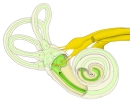
・膜(性)迷路の外側、つまり骨(性)迷路との間の空隙は外リンパで満たされている。
・「内・外リンパの間には交通がない。」(日本人体解剖)
以下は「Wikipedia」の解説の一部を箇条書きにしたものになる。詳しくは下にある解説を参照のこと。
・イオン組成は陽イオンであるカリウム(potassium)が中心となる。
(カリウムイオンは血管条が分泌する。)
・「スカルパ液」とも呼ばれる。
|

|
骨性・膜性迷路 |
迷路・神経 |
以下は「Wikipedia」の解説文となる。
Endolymph is the fluid contained in the membranous labyrinth of the inner ear. The major cation in endolymph is potassium, with the values of sodium and potassium concentration in the endolymph being 0.91 mM and 154 mM, respectively. It is also called Scarpa's fluid, after Antonio Scarpa.
【Structure】
The inner ear has two parts: the bony labyrinth and the membranous labyrinth. The membranous labyrinth is contained within the bony labyrinth, and within the membranous labyrinth is a fluid called endolymph. Between the outer wall of the membranous labyrinth and the wall of the bony labyrinth is the location of perilymph
【 語 句 】
・membranous labyrinth:膜(性)迷路 ・inner ear:内耳 ・cation:陽イオン ・potassium:カリウム ・sodium:ナトリウム ・mM:millimolar ミリモル(濃度) ・bony labyrinth:骨(性)迷路 ・perilymph:外リンパ
【Composition】
Perilymph and endolymph have unique ionic compositions suited to their functions in regulating electrochemical impulses of hair cells. The electric potential of endolymph is ~80-90 mV more positive than perilymph due to a higher concentration of K compared to Na.
The main component of this unique extracellular fluid is potassium, which is secreted from the stria vascularis. The high potassium content of the endolymph means that potassium, not sodium, is carried as the de-polarizing electric current in the hair cells. This is known as the mechano-electric transduction (MET) Endolymph has a high positive potential (80–120 mV in the cochlea), relative to other nearby fluids such as perilymph, due to its high concentration of positively charged ions. It is mainly this electrical potential difference that allows potassium ions to flow into the hair cells during mechanical stimulation of the hair bundle. Because the hair cells are at a negative potential of about -50 mV, the potential difference from endolymph to hair cell is on the order of 150 mV, which is the largest electrical potential difference found in the body.
【Function】
- Hearing: Cochlear duct: fluid waves in the endolymph of the cochlear duct stimulate the receptor cells, which in turn translate their movement into nerve impulses that the brain perceives as sound.
- Balance: Semicircular canals: angular acceleration of the endolymph in the semicircular canals stimulate the vestibular receptors of the endolymph. The semicircular canals of both inner ears act in concert to coordinate balance.
【 語 句 】
・ionic:イオンの ・composition:構成 ・electrochemical:電気化学の ・impulse:衝撃 ・hair cell:有毛細胞 ・secrete:分泌する ・stria vascularis:血管条 ・de-polarizing:脱分極性の ・mechano-electric transduction:機械-電気変換 ・stimulation:刺激 ・cochlear duct:蝸牛管 ・receptor cell:受容器細胞 ・semicircular canal:半規管 ・angular acceleration:
角加速度 ・vestibular receptors:前庭受容体 ・in concert:一斉に
